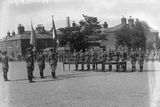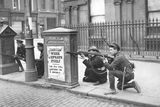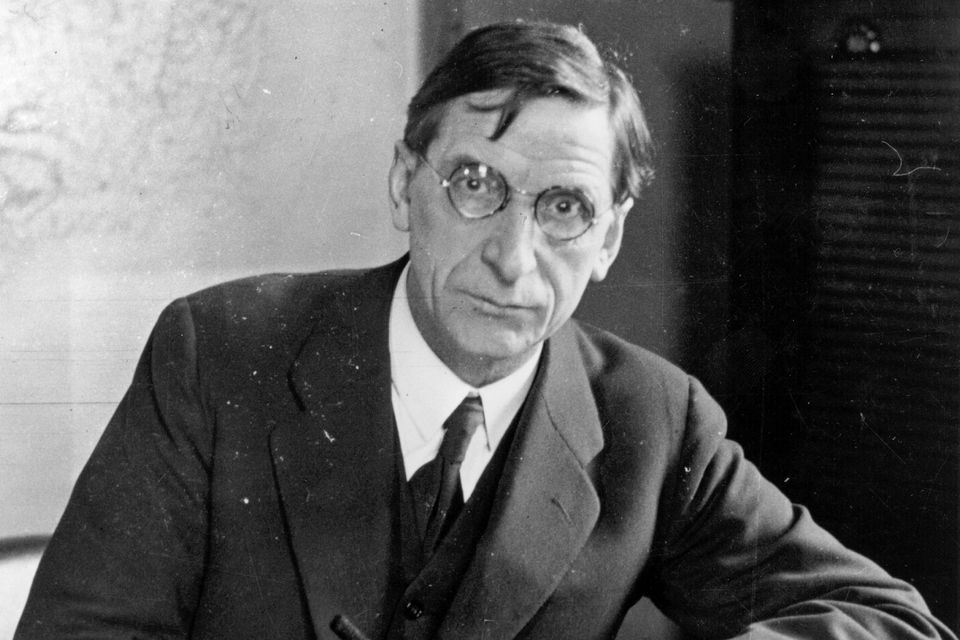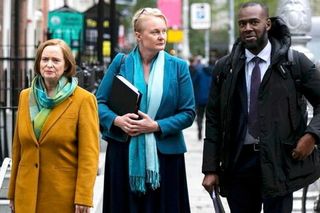The People’s Flag: Anglo-Irish relations and Ireland’s declaration of neutrality in 1939
Lesson plan 2



The Anglo-Irish Treaty: The Framework for Anglo-Irish Relations
⬤ The Anglo-Irish Treaty of 1921 dominated Anglo-Irish Relations during the period 1922-1938. It shaped the policies of both the Cosgrave and de Valera governments. Despite taking opposing sides in the Civil War, each leader had to work within the framework of the Treaty.
The main aspects of the Treaty that impacted on Anglo-Irish Relations were;
⬤ The new Irish state was a self-governing ‘Dominion’ of the British Empire. It would be known as the Irish Free State. It shared the same status as Canada, Australia, etc.
⬤ The British King was, in effect, the Irish head of state. He would be represented in Ireland by a Governor-General. One of his main tasks was to sign into law bills passed by the Dáil.
⬤ All elected members of the Dáil/Seanad had to take an oath of allegiance to the constitution of the Irish Free State and to be faithful to the King (and his successors).
⬤ The Irish Free State extended over twenty-six counties of Ireland but not the 6 counties of Northern Ireland. The border was to be later reviewed by a Boundary Commission.
⬤ For security purposes, Britain was to have control and access to three Irish ports, i.e., the Treaty Ports. The Irish state would also continue to pay a part of Britain’s WWI debt.
⬤ The Treaty not just determined Anglo-Irish relations but shaped the entire foreign policy of the new Irish state. Any developments in this area had to be considered with regard to the Treaty.
National Army - Commissioning of Volunteer Cadets. Commissions Ceremony taking place. 1935 (Part of the NPA/Independent Newspapers Collection)
1931 Statute of Westminster
⬤ Irish diplomatic efforts contributed to a landmark decision by the British government regarding the relationship with the dominions. It was proof that the British government accepted that a new relationship now existed with the dominions. This decision was the Statute of Westminster.
The main features of this Act of Parliament regarding Anglo-Irish relations were;
⬤ The British parliament could no longer make any laws for the Irish State.
⬤ The Irish parliament could remove any existing British laws that applied to Ireland.
⬤ The Irish parliament could pass laws that affected Ireland’s international relations.
⬤ The passing of this law was a triumph for the diplomatic policy of Cosgrave and his government. They had within ten years of the Treaty achieved both greater Irish independence while maintaining good relations with Britain. They did not get much time to develop their policy further. Within three months of the passing of the Statute of Westminster, Cosgrave lost power.
1932 – De Valera and a new era in Anglo-Irish Relations
⬤ De Valera had opposed the Anglo-Irish Treaty. His had continued his opposition during the Civil War. He viewed the Treaty as limiting Irish independence. He maintained this viewpoint when he established a new political party, Fianna Fáil (1926). They won the 1932 general election. This victory led to a new direction in Anglo-Irish relations.
⬤ De Valera was open in his desire for Ireland to become a republic and dismantle the Anglo-Irish Treaty. He was also practical as he did not want to create a crisis in Anglo-Irish relations.
⬤ The coming to power of de Valera coincided with a realisation of the full implications of the Statute of Westminster. It allowed him to independently revise the Anglo-Irish Treaty.
1932 – Abolition of the Oath
⬤ During the 1932 election campaign, de Valera had promised to remove the oath to the British King. He had described it as an ‘intolerable burden’ on the Irish people. For him, the oath was the hated symbol of British domination of Ireland. Its removal would be the first priority.
⬤ In March 1932, de Valera informed the British government of his intention to remove the oath. They were alarmed but were unsure how to react due to the Statute of Westminster.
⬤ In May 1932, the Dáil voted to abolish the oath. It was delayed in the Senate but became law in May 1933. It was a significant step in asserting Irish independence and revising the Treatry.
⬤ On this issue, the British government decided not to react. At first, they worried if other dominions might do the same but their fears were unfounded. It did create tensions in Anglo-Irish relations.
Free State soldiers fighting against Republican forces at O’Connell Bridge in Dublin during the Irish Civil War. (Photo by Brooke/Topical Press Agency/Getty Images)
1932 – Economic War
⬤ It was not the symbolism of the oath that caused a serious worsening of Anglo-Irish relations. This was caused by the mutual actions taken by both states on the more practical issue of trade. Anglo-Irish relations worsened due to an economic clash between the Irish state and Britain. De Valera hoped to create a self-sufficient economy and reduce dependency on Britain.
⬤ In 1932, de Valera stopped the repayment of land annuities to the British government.
⬤ Britain responded by imposing a 20% duty on the import of Irish cattle and farm produce.
⬤ The Irish government responded with a similar tax on British imports, i.e., a trade war.
⬤ Anti-British feeling in Ireland ran high – ‘Burn everything English except their coal’.
The Economic War added a new layer of conflict to the already poor Anglo-Irish relationship. Despite the cost to both economies, the issue was not resolved until 1938.
1933 – Abolition of the Right of Appeal to the Privy Council
⬤ De Valera strongly believed that to be an independent nation, it was essential that an Irish state should no longer be subjected to the decisions of courts in Britain, i.e. the Privy Council.
⬤ In 1933, he proposed the abolition of the right to appeal to the Privy Council in London.
⬤ The final court of appeal for Irish people should be based in Ireland and not in Britain.
⬤ The Irish Supreme Court would become the court of final appeal within the Irish state.
⬤ In 1935, de Valera was vindicated when the Privy Council itself agreed with the decision.
⬤ The ending of the right to appeal to the Privy Council was possible because of the 1931 Statute of Westminster. The historic judicial link between Britain and Ireland was ended.
1935 – The Irish Nationality and Citizen Act
⬤ As de Valera’s Anglo-Irish policy continued to establish greater Irish independence, he believed it was time to legally and clearly establish the distinct nature of Irish citizenship.
⬤ Irish citizenship was defined as those born within the area of the Irish Free State.
⬤ Irish citizenship could be claimed by descent if their father was an Irish citizen.
⬤ A further Act, the Aliens Act, defined British citizens as ‘aliens’, i.e, non-Irish.
These measures were very symbolic as they clear that the Irish state and its people were a completely separate entity from the British state.
1936 – External Relations Act
⬤ In December 1936, a political crisis developed in Britain regarding the Crown. King Edward VIII abdicated for personal reasons. De Valera took advantage to promote his policy.
⬤ The External Relations Act was rushed through the Dail (within 48 hours).
⬤ The Act removed all reference to the Crown from the Irish constitution.
⬤ The King could only be used for formal matters if the government decided to do so.
1937 – The Constitution
⬤ By 1937, de Valera was politically confident to make the most significant change to the status of the Irish state. He decided to replace the 1922 constitution with a new constitution.
⬤ The constitution declared that Irish sovereignty came from the people (not the Crown).
⬤ The head of state would be the President. This removed the King as head of state.
⬤ The constitution laid claim to the territory of Northern Ireland (Articles 2 and 3).
The 1937 constitution effectively declared the Irish state to be an independent republic, but without stating that fact. It made the Irish state completely independent from Britain.
1938 Anglo-Irish Agreement
⬤ The British Prime Minister, Neville Chamberlain face a worsening international situation with the threat of Nazi Germany. He wanted to improve relations with the Irish state.
⬤ The Economic War was brought to an end. All trade tariffs on imports were removed.
⬤ Ireland agreed to pay £10 million to Britain to settle the issue of land annuities.
⬤ Britain agreed to give up use of the three Treaty ports and return them to the Irish state.
The Agreement was proof that Britain accepted the changes made by de Valera in his Anglo-Irish policy. He had furthered Irish independence without a break-down in relations.
World War Two
On September 1st 1939, the Second World War began with the German invasion of Poland. The next day, Saturday September 2nd, a special sitting of the Dáil occurred. De Valera declared that the Irish state intended to adopt a policy of neutrality. This was the position of most nations in Europe. What made Ireland’s position unique was that it was still technically (but not actively) linked to the British Commonwealth. To help the State endure the crisis, the Emergency Powers Act was voted through the Dáil. The decision to adopt a policy of neutrality was a clear statement that the Irish State was a completely independent nation.
Join the Irish Independent WhatsApp channel
Stay up to date with all the latest news



















